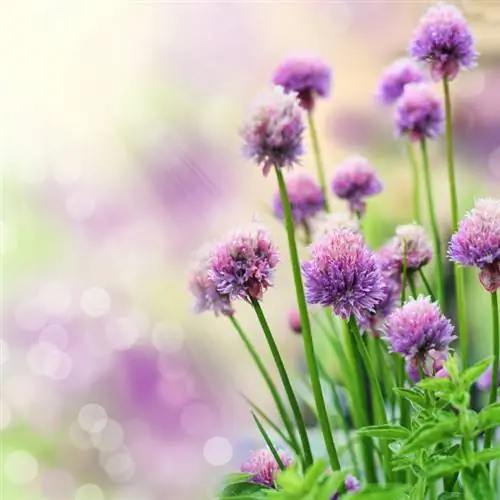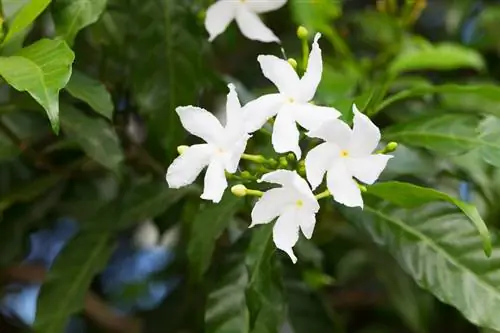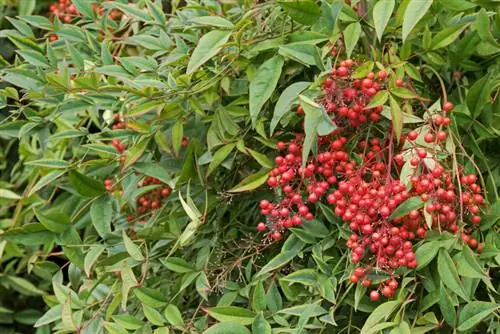- Author admin [email protected].
- Public 2023-12-25 17:45.
- Last modified 2025-01-23 11:22.
The spider plant creates a natural feel-good atmosphere, cleans the air, sets decorative accents and brings calm to the hectic pace of everyday life. To ensure that this miraculous houseplant thrives without any problems, we answer all the fundamental questions about professional cultivation here.

How do you properly care for spider plants?
Spider spider care includes a bright location with mild sun, room temperatures above 10°C, moderate watering with low-lime water and diluted liquid fertilizer every 2-3 weeks from April to October. In winter, water and fertilizer requirements are reduced.
Care tips
The agenda for proper spider plant care includes these points:
- Bright location with mild morning or evening sun
- Normal room temperatures with temperatures above 10 degrees Celsius
- Watering moderately with low-lime water, without waterlogging
- Administer diluted liquid fertilizer every 2-3 weeks from April to October
The houseplant does not go into hibernation in the true sense of the word. Nevertheless, the need for irrigation water is reduced from November to March. Since there is hardly any growth, the spider plant receives no fertilizer during this time.
Which location is suitable?
The more intensive the photosynthesis, the more magnificent the decorative foliage plant develops. Therefore, assign a spider plant a sunny location with shade from the blazing midday sun. We recommend supplementary lighting in low-light corners of rooms during the winter. In addition, the ideal location should be like this:
- Normal room temperatures, not below 10 degrees Celsius
- The highest possible humidity of more than 50 percent
read more
Cut green lilies correctly
Regular pruning is not part of the regular care program for a spider plant. Regardless of this, the houseplant is extremely tolerant of cutting. Cutting can therefore easily be considered in these cases:
- Reducing size and scope
- Acquiring offshoots
- Cutting out wilted flowers
- Removing seed heads
Completely withered leaves are better plucked out instead of cutting them off. When a cut is made, a small piece of leaf always remains on the plant, which poses the risk of rot.read more
Watering green lilies
Overall, the water requirements of a spider plant are at a medium level. During the main growing season, the green plant thrives if it is kept constantly moist. Growth rests from November to March, so the need for watering is reduced accordingly. Ideally, you should use collected rainwater or stale tap water, as the spider plant prefers slightly acidic soil.read more
Fertilize green lilies properly
In order to produce the decorative leaves, the spider plant cannot do without additional nutrients. Therefore, fertilize every 2-3 weeks from April to October with a liquid fertilizer for green plants. The dosage depends on the size, the site conditions and the speed of growth. Fertilizer is usually not required during the winter. Only in warm locations with appropriate growth should you apply some fertilizer every 4 weeks from October to March.
If a cat is within reach of a spider plant, we recommend using organic fertilizer such as liquid compost, horn meal or worm tea.read more
Propagate green lilies
Where the spider plant spreads a good mood as a solitary plant, the desire for more specimens grows. You can choose from the following methods for propagation:
- Dividing the root ball
- Cut off rooted children and plant them
- Treat offshoots like lowering plants and let them root
Do not cut the root ball with a knife. Ideally, you should pull the potted spider plant apart with your hands so that there are only marginal injuries to the roots.read more
Repotting
If a spider plant becomes too cramped in the pot, it should be repotted in spring. Follow these steps:
- Create drainage over the bottom opening in the new pot using potsherds or gravel
- Fill in the substrate halfway up to make a depression in it with your fist
- Unpot the spider plant, shake off the used soil and plant it in the middle
- Do not insert deeper than before
read more
Is green lilies poisonous?
A spider plant poses no he alth risk. The houseplant is therefore one of the favorites for harmless indoor greenery. This applies equally to humans and animals.read more
Brown leaves
If brown leaves develop on a spider plant, this is not a cause for concern. Nevertheless, the cause should be found out and remedied. The most common triggers at a glance:
- Ball dryness
- Bright midday sun
- Sudden change of location
Too low humidity also causes brown leaves. Therefore, spray the spider plant with lime-free water every few days or place a humidifier in the room.read more
Yellow leaves
With yellow leaves, the spider plant expresses its displeasure when it suffers a deficiency due to neglect in care. The yellow color signals that the plant lacks iron. The damage known as leaf chlorosis occurs when irrigation water that is too hardy is used. Although the fertilizer contains enough iron, this nutrient is bound by too much lime and does not find its way into the decorative leaves. Therefore, switch the water supply to collected rainwater or decalcified tap water.
Another cause of yellow leaves is a location that is too dark, which impairs the vital chlorophyll production in the foliage. Last but not least, pest infestation comes into consideration. When cunning lice or thrips suck the juice out of a spider plant, the leaves turn yellow.read more
Why does the spider plant get brown tips?
A common damage to spider plants is brown tips. This is how the plant reacts when its leaves constantly hit a surface. It is therefore best to cultivate the green plant in a hanging basket or on a flower stand so that the long shoots can dangle down.
If the brown tips bother you, they can be cut off with disinfected scissors. Do not cut into the green, but leave a tiny piece of the discolored tissue of 1-2 millimeters on the leaf.read more
Is the spider plant poisonous to cats?
The spider plant is at the top of the hit list for cats when it comes to nibbling plants. That's a good thing, because it contains no toxins and functions similarly to classic cat grass. Only the seeds should not get into kitty's stomach as they could cause nausea. Therefore, cut out the withered flowers from a spider plant immediately.read more
The spider plant as a houseplant
In the ranking of the most popular house plants, the spider plant has secured a place at the top of the list for decades. This is hardly surprising, given their frugal, unpretentious nature and their distinctive appearance. The spider plant owes its middle name, official grass, to the fact that it not only filters out toxins from the air it breathes in the office, but also accepts a weekend without care without complaint.
The spider plant also functions as a lush ornament on the summer balcony, as long as it is not confronted with the blazing midday sun and is put away in time in autumn. For followers of the Feng Shui theory of harmony, the delicate foliage plant serves as a power source that replaces used life energy.read more
Growing the spider plant hydroponically
The spider plant is considered a prime example of a hydroponic houseplant. However, you should decide on this option in advance, because even the frugal spider plant rarely tolerates a switch from earth roots to water roots afterwards.
In order to try out the hydroculture experiment, beginners can use children. Simply place it in the hydroponic pot and start with a slightly increased water level. As the roots sprout, the water level can be lowered to normal levels.read more
The spider plant purifies the air
Supporters of the Feng Shui philosophy have long known: the spider plant helps purify the air in rooms. Therefore, it is not only often found in living rooms, but also adorns offices and work spaces. The African foliage plant not only improves the visual appearance of the room climate, but also filters out toxins from the air we breathe.read more
Propagate spider plants through cuttings
Hardly any other plant produces offshoots as generously as the spider plant. Clever hobby gardeners therefore buy a maximum of one plant and grow additional specimens with the help of children. A tried and tested procedure goes like this:
- Cut off rooted daughter plants with 5 cm long leaves
- Defoliate offshoots in the lower third
- Plant in a pot with loose potting soil and keep constantly moist
You are on the safe side if you initially leave the connection between the offshoot and the mother plant intact. Place the nursery pot in the immediate vicinity and treat the daughter plants similarly to a planter. The separation only takes place when the child has developed well.read more
The seeds of the spider plant
Some time after flowering, the spider plant forms small capsule fruits in which 2-3 millimeters large, black seeds develop. If it is a plain-green wild species, you can try sowing it. With variegated hybrids, however, hops and m alt are lost if you want to grow new plants from the seeds.read more
Is the spider plant hardy?
The spider plant is native to South Africa. As a result, it is not hardy and is considered an ideal houseplant. There is nothing wrong with placing the decorative foliage plant on the balcony during the summer, as it develops particularly luxuriantly in the open air. If the temperatures fall below 10 degrees, the spider plant moves indoors.read more
The spider plant species
The spider plant (Chlorophytum comosum) is the only species of its genus to have established itself as a houseplant in our latitudes. This is a bit surprising, as there are a number of potential candidates for the home windowsill among the more than 100 other species. After all, you can choose from distinctive spider plant varieties that have decoratively marked leaves. The Mandaianum variety impresses with yellow central stripes on dark green foliage.read more
The most beautiful varieties
- Variegatum: a magnificent variety with white-edged, lively green leaves up to 40 centimeters long
- Vittatum: impresses with lanceolate leaves decorated with a white or cream-colored central stripe
- Picturatum: highlights its long decorative leaves with a yellow central stripe
- Bonnie: romantically curled foliage makes this variety stand out from the crowd
- Ocean: a creative variety with light green foliage and white edges






